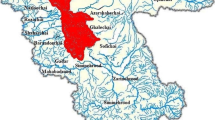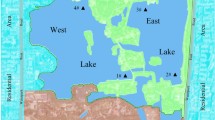Abstract
Purpose
This study investigated the prevalence and molecular detection of Cryptosporidium spp. in catfish (Clarias gariepinus).
Methods
A total of 300 Carias gariepinus fish were collected from two freshwater sources: the Nile River (180) and drainage canals (120). The stomach and intestine epithelium of each individual fish sample were screened by modified Ziehl–Neelsen (mZN) staining technique for the detection of Cryptosporidium oocysts followed by the serological survey for detection of Cryptosporidium antibodies using Enzyme-Linked Immunosorbent Assay (ELISA) and molecular characterization using complemented DNA polymerase chain reaction (cPCR).
Results
ELISA showed higher prevalence of 69.3% than that prevalence obtained by mZN, 64% for the total examined Clarias gariepinus fish. Also, higher prevalence of Cryptosporidium infection 65.5% and 75.8% obtained by ELISA than 61.1% and 68.3% by mZN, in both fish groups from Nile River and Drainage canal, respectively. PCR analysis revealed the expected positive bands at 1056 bp. DNA sequencing and phylogenetic analysis proved that the positive-PCR Cryptosporidium isolate identified in the present study was Cryptosporidium molnari.
Conclusion
Freshwater fishes (Clarias gariepinus) are subjected to a high infection rate with Cryptosporidium spp.; the drainage canals obtained fishes showed higher prevalence than that collected from Nile River which indicates an important public health problem and a potential risk of drainage canals in Egypt. ELISA showed higher prevalence of cryptosporidiosis than mZN, for the total examined Clarias gariepinus fish and phylogenetic analyses confirmed this protozoal organism to be a novel species of Cryptosporidium molnari.




Similar content being viewed by others
References
Ryan UNA, Fayer R, Xiao L (2014) Cryptosporidium species in humans and animals: current understanding and research needs. Parasitol 141(13):1667–1685. https://doi.org/10.1017/S0031182014001085
Ghazy AA, Abdel-Shafy S, Shaapan RM (2016) Cryptosporidiosis in animals and man: 3. Prevention and Control As J Epidemiol 9(1–3):1–9. https://doi.org/10.3923/aje.2016.1.9
Obateru OA, Bojuwoye BJ, Olokoba AB, Fadeyi A, Fowotade A, Olokoba LB (2017) Prevalence of intestinal parasites in newly diagnosed HIV/AIDS patients in Ilorin. Nigeria Alex J Med 53(2):111–116. https://doi.org/10.1016/j.ajme.2016.04.001
Elfadaly HA, Hassanain NA, Hassanain MA, Barakat AM, Shaapan RM (2018) Evaluation of primitive ground water supplies as a risk factor for the development of major waterborne zoonosis in Egyptian children living in rural areas. J Infec Pub Health 11(2):203–208. https://doi.org/10.1016/j.jiph.2017.07.025
Desai NT, Sarkar R, Kang G (2012) Cryptosporidiosis: an under-recognized public health problem. Trop parasitol 2(2):91. https://doi.org/10.4103/2229-5070.105173
Shaapan RM (2016) the common zoonotic protozoal diseases causing abortion. J Paras Dis 40(4):1116–1129. https://doi.org/10.1007/s12639-015-0661-5
Daniels ME, Smith WA, Jenkins M (2018) Estimating Cryptosporidium and Giardia disease burdens for children drinking untreated groundwater in a rural population in India. PLoS Neg Trop Dis 12(1):e0006231. https://doi.org/10.1371/journal.pntd.0006231
Zahedi A, Ryan U (2020) Cryptosporidium–an update with an emphasis on foodborne and waterborne transmission. Res Vet Sci 132:500–512. https://doi.org/10.1016/j.rvsc.2020.08.002
Cook N, Nichols RAB, Wilkinson N, Paton CA, Barker K, Smith HV (2007) Development of a method for detection of Giardia duodenalis cysts on lettuce and for simultaneous analysis of salad products for the presence of Giardia cysts and Cryptosporidium oocysts. Appl Envir Microbiol 73(22):7388–7391. https://doi.org/10.1128/AEM.00552-07
Bhaijee F, Subramony C, Tang SJ, Pepper DJ (2011) Human immunodeficiency virus-associated gastrointestinal disease: common endoscopic biopsy diagnoses. Pathol Res Int 26:2047. https://doi.org/10.4061/2011/247923
Geurden T, Claerebout E, Vercruysse J, Berkvens D (2008) A Bayesian evaluation of four immunological assays for the diagnosis of clinical cryptosporidiosis in calves. Vet J 176(3):400–402. https://doi.org/10.1016/j.tvjl.2007.03.010
Hassanain MA, Khalil FAM, Abd El-Razik KA, Shaapan RM (2011) Prevalence and molecular discrimination of Cryptosporidium parvum in calves in Behira Provinces, Egypt. Res J Parasitol 6(31):101-108. https://scialert.net/abstract/?doi=jp.2011.101.108
Costa D, Soulieux L, Razakandrainibe R, Basmaciyan L, Gargala G, Valot S, Dalle F, Favennec L (2021) Comparative performance of Eight PCR methods to detect Cryptosporidium Sp. Pathogens 10(6):647. https://doi.org/10.3390/pathogens10060647
Karanis P (2018) the truth about in vitro culture of Cryptosporidium species. Parasitol 145(7):855–864. https://doi.org/10.1017/S0031182017001937
Paparini A, Yang R, Chen L, Tong K, Gibson-Kueh S, Lymbery A, Ryan UM (2017) Cryptosporidium in fish: alternative sequencing approaches and analyses at multiple loci to resolve mixed infections. Parasitol 144(13):1811–1820. https://doi.org/10.1017/S0031182017001214
Bolland SJ, Zahedi A, Oskam C, Murphy B, Ryan U (2020) Cryptosporidium bollandi n. sp. (Apicomplexa: Cryptosporidiiae) from angelfish (Pterophyllum scalare) and Oscar fish (Astronotus ocellatus). Exp Parasitol 217:107956. https://doi.org/10.1016/j.exppara.2020.107956
Golomazou E, Malandrakis EE, Panagiotaki P, Karanis P (2021) Cryptosporidium in fish: implications for aquaculture and beyond. Water Res. https://doi.org/10.1016/j.watres.2021.117357
Couso-Pérez S, Ares-Mazás E, Gómez-Couso H (2019) First report of Cryptosporidium molnari-like genotype and Cryptosporidium parvum zoonotic subtypes (IIaA15G2R1 And IIaA18G3R1) in Brown Trout (Salmo trutta). J Parasitol 105(1):170–179. https://doi.org/10.1645/18-83
Ammar M, Arafa MI (2013) Cryptosporidium and other zoonotic parasites in Oreochromis niloticus in Assiut governorate. Assiut Vet Med J 55:142–151. https://doi.org/10.21608/AVMJ.2013.172289
Argungu LA, Siraj SS, Christianus A, Amin MSN, Daud SK, Abubakar MS, Abubakar IA, Aliyu-Paiko MA (2017) simple and rapid method for blood collection from walking cat-fish, Clarias batrachus (Linneaus, 1758). Iran J Fish Sci 17(3): 935-944 https://hdl.handle.net/1834/12200
Yang R, Dorrestein GM, Ryan U (2016) Molecular characterization of a disseminated Cryptosporidium infection in a Koi carp (Cyprinus carpio). Vet Parasitol 22:53–56. https://doi.org/10.1016/j.vetpar.2016.06.027
Henriksen SA, Pohlenz JFL (1981) Staining of Cryptosporidia by a modified Ziehl-Neelsen technique. Act Vet Scand 22(3–4):594–596. https://doi.org/10.1186/bf03548684
Casemore DP, Armstrong M, Sands RL (1985) Laboratory diagnosis of cryptosporidiosis. J Clin Pathol 38(12):1337–1341. https://doi.org/10.1136/jcp.38.12.1337
Xiao L, Bern C, Limor J, Sulaiman I, Roberts J, Checkley W, Cabrera L, Gilman RH, Lal AA (2001) Identification of 5 types of Cryptosporidium parasites in children in Lima. Peru J Inf Dis 183(3):492–497. https://doi.org/10.1086/318090
Ghazy AA, Abdel-Shafy S, Shaapan RM (2015) Cryptosporidiosis in animals and man: 2. Diagnosis. As J Epidemiol 8(4):84–103. https://doi.org/10.3923/aje.2015.84.103
Arrowood MJ, Sterling CR (1987) Isolation of Cryptosporidium oocysts and sporozoites using discontinuous sucrose and isopycnic Percoll gradients. J parasitol 73:314–319. https://doi.org/10.2307/3283104
Shaapan R, Toaleb NI, Abdel-Rahman EH (2021) Detection of Toxoplasma gondii-specific immunoglobulin (IgG) antibodies in meat juice of beef. Iraqi J Vet Sci 35(2):319–324. https://doi.org/10.33899/ijvs.2020.126829.1390
Hassanain NA, Hassanain MA, Ahmed WM, Shaapan RM, Barakat AM, El-Fadaly HA (2013) Public health importance of foodborne pathogens. W J Med Sci 9(4):208–222. https://doi.org/10.5829/idosi.wjms.2013.9.4.8177
Zanguee N, Lymbery JA, Lau J, Suzuki A, Yang R, Ng J, Ryan U (2010) Identification of novel Cryptosporidium species in aquarium fish. Vet Parasitol 174(1–2):43–48. https://doi.org/10.1016/j.vetpar.2010.08.006
Lalonde LF, Gajadhar AA (2009) Effect of storage media, temperature, and time on preservation of Cryptosporidium parvum oocysts for PCR analysis. Vet Parasitol 160:185–189. https://doi.org/10.1016/j.vetpar.2008.11.022
Jellison K, Hemond HF, Schauer DB (2002) Sources and species of Cryptosporidium oocysts in the Wachusett Reservoir watershed. Appl Env Microbiol 68(2):569–575. https://doi.org/10.1128/AEM.68.2.569-575.2002
Thompson JD, Higgins DG, Gibson TJ, Clustal W (1994) improving the sensitivity of progressive multiple sequence alignment through sequence weighting, position-specific gap penalties and weight matrix choice. Nuc Acid Res 22(22):4673–4680. https://doi.org/10.1093/nar/22.22.4673
O’Donoghue PJ (1995) Cryptosporidium and cryptosporidiosis in man and animals. Int J Parasitol 25(2):139–195. https://doi.org/10.1016/0020-7519(94)E0059-V
Xiao L, Fayer R, Ryan U, Upton SJ (2004) Cryptosporidium taxonomy: recent advances and implications for public health. Clin Microbiol Rev 17(1):72–97. https://doi.org/10.1128/CMR.17.1.72-97.2004
Alvarez-Pellitero P, Sitja-Bobadilla A (2002) Cryptosporidium molnarin. sp. (Apicomplexa: Cryptosporidiidae) infecting two marine fish species, Sparusaurata L and Dicentrarchuslabrax L. Int J parasitol 32:1007–1021. https://doi.org/10.1016/S0020-7519(02)00058-9
Barugahare R, Dennis MM, Becker JA, Slapeta J (2011) Detection of Cryptosporidium molnari oocysts from fish by fluorescent-antibody staining assays for Cryptosporidium spp affecting humans. Appl Env Microbiol 77(5):1878–1880. https://doi.org/10.1128/AEM.02691-10
Omoruyi BE, Nwodo UU, Udem CS, Okonkwo FO (2014) Comparative diagnostic techniques for Cryptosporidium infection. Molec 19(2):2674–2683. https://doi.org/10.3390/molecules19022674
Mallik A, Xavier KM, Naidu BC, Nayak BB (2021) Eco-toxicological and physiological risks of microplastics on fish and their possible mitigation measures. Sci Tot Env 779:146433. https://doi.org/10.1016/j.scitotenv.2021.146433
Palermo C (2016) Cryptosporidium in fish: Morphological and molecular characterization (Doctoral dissertation), Murdoch University in Perth, Australia. PHD Thesis https://researchrepository.murdoch.edu.au/id/eprint/35248
Sitjà-Bobadilla A, Padrós F, Aguilera C, Alvarez-Pellitero P (2005) Epidemiology of Cryptosporidium molnari in Spanish gilthead sea bream (Sparus aurata L.) and European sea bass (Dicentrarchus labrax L.) cultures: from hatchery to market size. Appl Env Microbiol 71(1):131–139. https://doi.org/10.1128/AEM.71.1.131-139.2005
Murphy BG, Bradway D, Walsh T, Sanders GE, Snekvik K (2009) Gastric cryptosporidiosis in fresh water angelfish (Pterophyllum scalare). J Vet Diag Inv 21(5):722–727. https://doi.org/10.1177/104063870902100523
Morine M, Yang R, Ng J, Kueh S, Lymbery AJ, Ryan UM (2012) Additional novel Cryptosporidium genotypes in ornamental fishes. Vet Parasitol 190(3–4):578–582. https://doi.org/10.1016/j.vetpar.2012.06.036
Reid A, Lymbery A, Ng J, Tweedle S, Ryan U (2010) Identification of novel and zoonotic Cryptosporidium species in marine fish. Vet Parasitol 168(3–4):190–195. https://doi.org/10.1016/j.vetpar.2009.11.015
Certad G, Dupouy-Camet J, Gantois N, Hammouma-Ghelboun O, Pottier M, Guyot K, Benamrouz S, Osman M, Delaire B, Creusy C, Viscogliosi E (2015) Identification of Cryptosporidium species in fish from Lake Geneva (lac Leman) in France. PLoS One 10(7):e0133047. https://doi.org/10.1371/journal.pone.0133047
Alvarez-Pellitero P, Quiroga MI, Sitjà-Bobadilla A, Redondo MJ, Palenzuela O, Padrós F, Vázquez S, Nieto JM (2004) Cryptosporidium scophthalmi n. sp. (Apicomplexa: Cryptosporidiidae) from cultured turbot Scophthalmus maximus. Light and electron microscope description and histopathological study. Dis Aqua Org. 62(1–2): 133–145. https://int-res.com/articles/dao2004/62/d062p133.pdf
Egyed Z, Sreter T, Szell Z, Beszteri B, Dobos-Kovács M, Márialigeti K, Cornelissen AWC, Varga I (2002) Polyphasic typing of Cryptosporidium baileyi: a suggested model for characterization of Cryptosporidia. J parasitol 88(2):237–243. https://doi.org/10.1645/0022-3395(2002)088[0237:PTOCBA]2.0.CO;2
Ryan U, Xiao L, Read C, Zhou L, Lal AA, Pavlasek I (2003) Identification of novel Cryptosporidium genotypes from the Czech Republic. Appl Env Microbiol 69(7):4302–4307. https://doi.org/10.1128/AEM.69.7.4302-4307.2003
Fayer R (2010) Taxonomy and species delimitation in Cryptosporidium. Exp Parasitol 124(1):90–97. https://doi.org/10.1016/j.exppara.2009.03.005
Palenzuela O, Alvarez-Pellitero P, Sitjà-Bobadilla A (2010) Molecular characterization of Cryptosporidium molnari reveals a distinct piscine clade. Appl Env Microbiol 76(22):7646–7649. https://doi.org/10.1128/AEM.01335-10
Certad G, Follet J, Gantois N, Hammouma-Ghelboun O, Guyot K, Benamrouz-Vanneste S, Fréalle E, Seesao Y, Delaire B, Creusy C, Even G (2019) Prevalence, molecular identification, and risk factors for Cryptosporidium infection in edible marine fish: a survey across sea areas surrounding France. Front Microbiol 10:1037. https://doi.org/10.3389/fmicb.2019.01037
Acknowledgements
Authors are very grateful and extend their thanks and gratitude to the soul of the late Prof Dr. Mohey A. Hassanain, Professor of Parasitology, Department of Zoonotic Diseases, NRC, Egypt for his encouragement and valuable guidance to finish this work.
Funding
This research received no specific grant from any funding agency in the public, commercial, or not-for-profit sectors.
Author information
Authors and Affiliations
Contributions
Dr. RMS: planned and design the study, serological, molecular investigation, and drafting the paper. Dr. FAA: sharing in the idea and study design, identification of Cryptosporidium sp. and participated in drafting the manuscript. Dr. KGV: sharing in study conception, laboratory work, interpreted the data results, and helped in manuscript preparation and Dr. GIS: involved in samples collection and preparation, sharing serological and molecular tests. All authors read and approved the final manuscript.
Corresponding author
Ethics declarations
Conflict of interest
The authors of the current work declare that they have no conflicts of interest in this study.
Ethical approval
The study was ethically cleared and approved by Medical Research Ethical Committee Research, National Statement on Ethical Conduct in Human and animals Research at National Research Centre, Egypt under registration number # 21-054#.
Significance
The freshwater fishes (Clarias gariepinus) are subjected to high infection rate with Cryptosporidium sp.; the drainage canals obtained fishes showed higher Cryptosporidium infection prevalence than that collected from River Nile which indicates an important public health problem and a potential risk of drainage canals in Egypt. ELISA showed higher prevalence of cryptosporidiosis than mZN for the total examined Clarias gariepinus fish. ELISA and PCR will be the "gold standard" where specificity and sensitivity will be very high, ensuring that undiagnosed Cryptosporidium infection does not occur. The phylogenetic analyses in this study confirmed this protozoal organism to be a novel detection of Cryptosporidium molnari in Clarias gariepinus fish.
Additional information
Publisher's Note
Springer Nature remains neutral with regard to jurisdictional claims in published maps and institutional affiliations.
Rights and permissions
About this article
Cite this article
Shaapan, R.M., Abdel-Ghaffar, F.A., Varjabedian, K.G. et al. Prevalence and Molecular Epidemiology of Cryptosporidium Infection in Clarias gariepinus Fish in Egypt. Acta Parasit. 67, 437–445 (2022). https://doi.org/10.1007/s11686-021-00483-4
Received:
Accepted:
Published:
Issue Date:
DOI: https://doi.org/10.1007/s11686-021-00483-4




